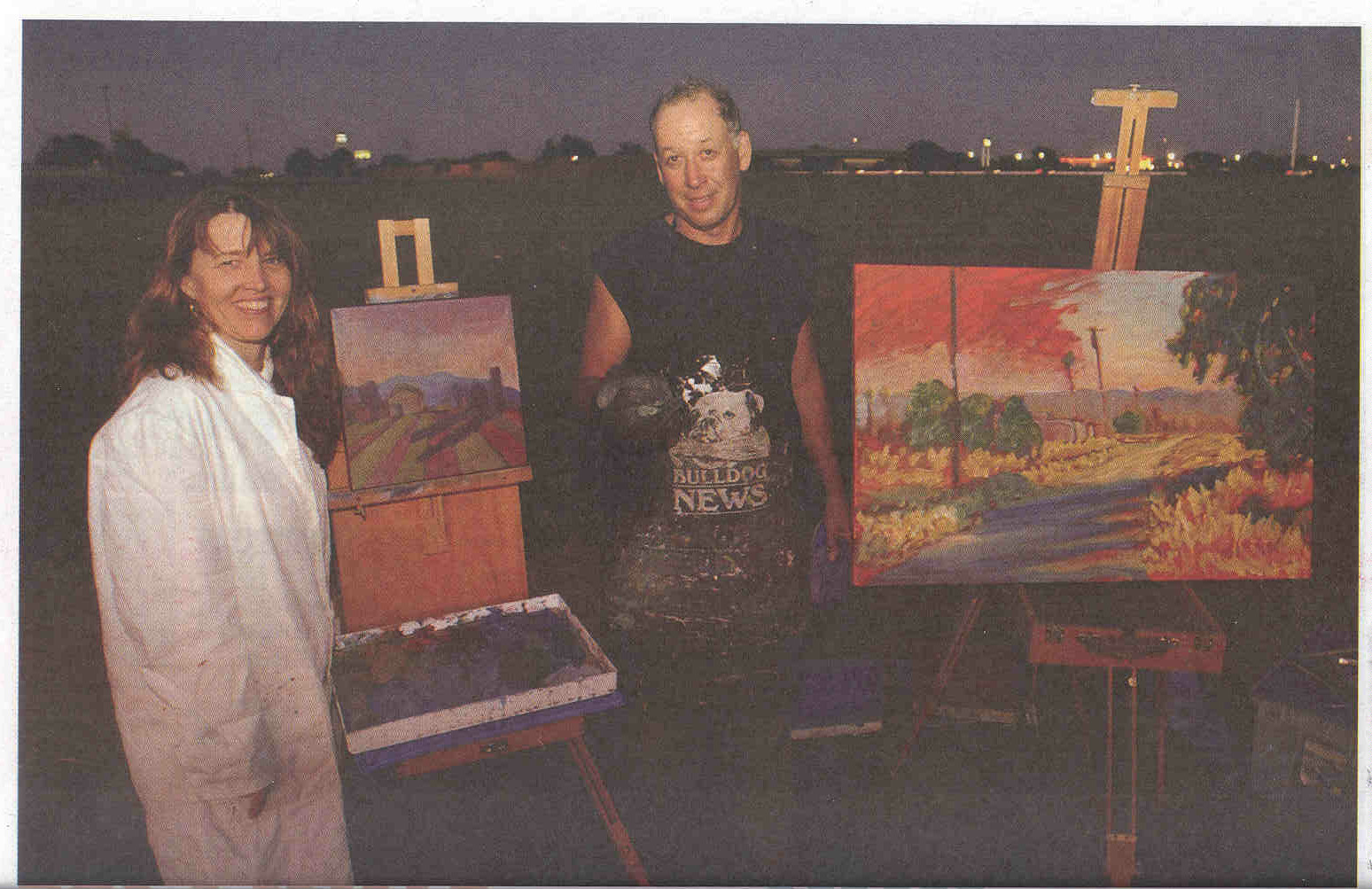 |
Photo By Larry Dalton
|
Melissa Chandon and Phil
Gross are both plein-air
painters who go out into the
landscape to capture long
shadows and dramatic colors.
|
| |
|
It’s easy for local city folk to compare
the horizontal Sacramento Valley with the
voluptuous Sierra peaks or the curvy
California coastline and feel helplessly
inferior--Sacramento’s the one flat-chested
girl at the party.
But if you look hard enough, the urban
center is surrounded by a subtle, natural
beauty. On the outskirts, the wild
sunflowers bloom along the highway in the
late summer, the city is blurred by haze,
and the sky turns lavender at dusk. In
orchards along the Delta, the sunny sides of
ripening pears blush pink.
Since the early 20th century, a few
painters have tried to capture the Valley
landscape, its distinctive agricultural
lands and riverbanks, but only on their way
to Yosemite or to the coast. Historically,
very few stayed in Sacramento to
paint--until recently.
In the late 20th century, painters like
Wayne Thiebaud, Gregory Kondos and Patrick
Dullanty (who died in 2004) prepared
colorful, stylized images of some of the
most familiar Valley landmarks. Thiebaud
painted agricultural crops as seen from the
sky. Kondos painted boats on the river, and
Dullanty captured the factories and
industrial buildings on the river’s banks.
All three taught younger painters how to
look at the Valley for material. Kondos
taught at Sacramento City College (SCC) for
27 years, according to his Web site. And
Dullanty taught at both SCC and Cosumnes
River College. Thiebaud taught first at SCC
and then for many years at UC Davis. He
still carries one class a year, even at the
age of 85.
“There was a period of time in which UC
Davis was one of the top in the world,” said
local landscape painter Melissa Chandon, “in
terms of the painters it had working in that
art department.”
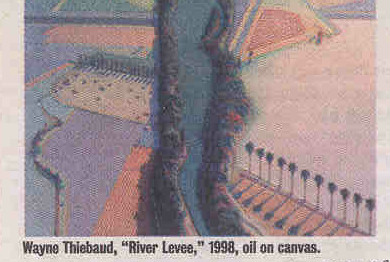 |
Wayne Thiebaud, "River
Levee," 1998, oil on canvas.
|
| |
|
Painters like Chandon, who once trained
with Thiebaud, are now seasoned adults in
their 40s and 50s, and many devote much of
their time to painting. They’ve begun to
take art as seriously as they took their
previous careers as stockbrokers or
marketing professionals, even geologists.
But living here and loving this landscape
isn’t always easy. It takes a unique person
to prefer the flat Valley to the drama of
the nearby mountains and coastline.
In “The
Unbearable Flatness of Being,” written
for SN&R by Ralph Brave in August 1999, the
writer asked Thiebaud for wisdom about how
to live on a flat plane. The artist called
the Valley “exotic” and reminded Brave that
the canvas itself was a flat surface.
“It’s sad, I think, that so many of us
get involved in making our lives a kind of
succession of nervous thrills. And I think
that’s disruptive of what living in our
heart is about--in other words, cooking and
eating, making gardens and making
children”--which Thiebaud also referred to
as “standing on flat ground and not getting
dissuaded from that kind of reality.”
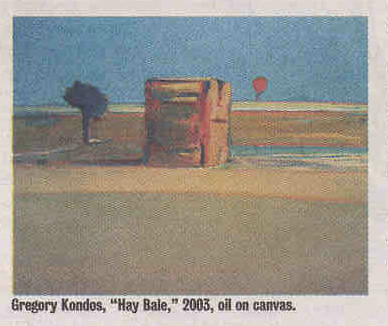 |
Gregory Kondos, "Hay
Bale," 2003, oil on canvas.
|
| |
|
If living in the shallow bowl of the
Valley grounds us and keeps us real, then
the new crop of landscape painters is
helping us to look at the vanishing beauty
of the area with fresh eyes. Scott Shields,
curator at the Crocker Art Museum, recently
noted that these painters have rejected new
buildings as subject matter, concentrating
instead on the surrounding fields and groves
slowly giving way to developments, and on
the city’s aged monuments, including icons
like the Tower Theatre, which some consider
as endangered as open space. Repeatedly,
painters focus on the eucalyptus, almond and
olive trees that break up the flatness of
the land, and on the loneliness of one
isolated manmade object--the huge water
towers or grain silos--in a field banked by
foothills.
Local painters tend to study one another
and even to “dialogue” with one another
through the images they choose to paint,
which has sparked a lot of discussion
recently on technique and subject matter.
That collaborative spirit is what led
gallery owner John Natsoulas, who hosts a
Sacramento Valley landscape conference at
the John Natsoulas Gallery in Davis every
summer, to claim that a movement is
developing--in effect, a “school” of
Sacramento Valley landscape painters.
This compelling river valley, seen by a
generation of artists trained under
world-renowned teachers, has sparked what
Natsoulas thinks of as a distinctive
approach to contrast and color. “It’s that
bright, bright, bright white light,” he
said.
Critics don’t necessarily agree. Even
some of the painters hint that the whole
“school” idea is something of a marketing
ploy.
Victoria Dalkey, art critic for The
Sacramento Bee, caused a stir this
summer when she noted that Natsoulas’ most
recent landscape show included few works
that “explore new territory, either actual
or aesthetic.” She referred to certain works
as “distressingly derivative” and “Thiebaud
knockoffs.”
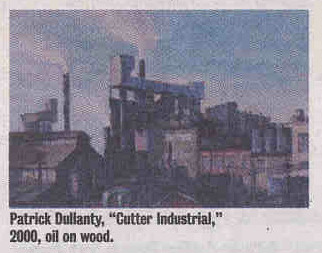 |
Patrick Dullanty, "Cutter
Industrial," 2000, oil on
wood.
|
| |
|
Though Natsoulas disagreed, he relished
the debate. Standing among the show’s four
floors of landscape paintings, he pointed to
an aerial view of crops that seemed to pay
homage to Thiebaud. “The aesthetic, those
colors,” said Natsoulas, “Wayne did that.”
He pointed to a nearby riverscape. “And the
river,” said Natsoulas, “Greg did that.”
But if the new generation of painters
tended to share subject matter with its
teachers, Natsoulas felt that it furthered
his point. They all were addressing similar
elements: the light, the agriculture and the
distant foothills.
“Wayne Thiebaud and Greg Kondos don’t own
the landscape,” said Natsoulas, who pointed
out that everyone who flies into the
Sacramento airport sees the same aerial view
of the fields as Wayne.
“My argument is that it’s the place,”
said Natsoulas. “It’s the spirit of the
goddamn place.”
Dalkey doesn’t reject the idea of a
school, but she urged caution. Many areas of
the country have their own local landscape
painters, she said, but they don’t all
inspire art movements.
Whether there really is a school of
landscape painters that will immortalize
what’s left of the agricultural fields,
riverbanks and groves that surround
Sacramento, only (art) history will tell.
But visiting the studios of five Sacramento
Valley landscape painters proved at least
one thing: The Valley is pretty enough to
stand tall next to its impressive neighbors.
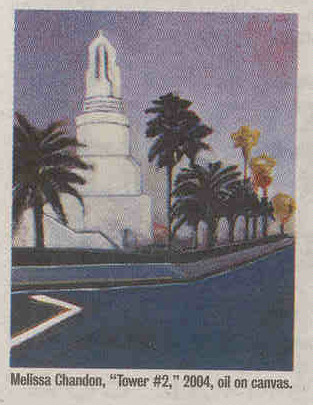 |
Melissa Chandon, "Tower
#2," 2004, oil on canvas.
|
| |
|
Melissa Chandon
Melissa Chandon, a slender woman
in her early 50s who looks like a polished
professional even while lounging in her
backyard, likes to head out into the
landscape itself with a couple of other
painters in the mornings. "I'm very, very
fond of that early-morning light," she
explained. "There's a haziness, a
cleanness," which changes in the afternoon.
"During the middle of the day, the sun is so
bright it's almost blinding; everything sort
of mutes down. There's less contrast, more
subtlety of color."
She and her troupe decide what they're
going to paint by 7 a.m., said Chandon.
They're out in the landscape by 8 a.m., and
they try to produce two paintings each
before everything looks different by 11 a.m.
"The light here is really sort of
amazing. It's almost as if it's polarized in
some way: the colors that you see in the
shadows; the richness of the shadows; the
contrast of the crops as they change through
the years; the dark, rich dirt; and the
water for the irrigation."
She's fascinated by the local fields of
safflower. "It's a green plant, and it has a
very bright yellow little blossom. And then,
as it matures, it turns sort of a beautiful
golden color, and then, just before they
harvest it, it turns a wonderful sort of
cinnamon."
Chandon began studying with Thiebaud
after Natsoulas convinced her to visit one
of his classes uninvited. She waited
outside, she said, until all the other
students left. Then she asked if she could
come and sit in the back and not say a word.
"I just felt like it was such an honor to
be there, just to shut up and take notes
was, like, perfectly fine," she said. "But
then he was like, 'Come on, bring your
paints. Come on, you can do this.'"
Thiebaud's a great inventor, said
Chandon. He urges students to change the
landscape for the sake of good composition.
She called it "editing."
"He says, 'Experiment. Try things. Work
on different surfaces. Don't be afraid. If
it doesn't work, take a scissors to it.'"
Did he speak passionately about the rows
of Valley crops he made famous?
"I asked him, 'How are you getting that
view?'" said Chandon. "And he said he was
most captivated by the levees. Forever more,
whenever I go over a levee or over a bridge,
I'm craning my neck to see: Oh yeah, it does
look better from up here."
Phil Gross
Phil Gross, a former geologist and
longtime feature in the local art community,
looks, even while holding paintbrushes in
his studio, like a tan, robust outdoorsman.
He paints with Chandon in the evenings and
sometimes travels with a ladder and a camera
so that he can get inspirational photographs
from a higher perspective. He originally
thought he wanted to paint the Sierras, but
compared with the Valley, he actually found
them boring. "It's already a postcard," he
said. "It's done."
Gross' interest in the Valley began with
his work as a geologist interested in the
movement of tectonic plates under
California. "We're the front bumper of a
plate, and for the last 200 million years,
we've been scraping exotic terrain from
another plate onto our plate, so we've got
all this stuff jumbled together here."
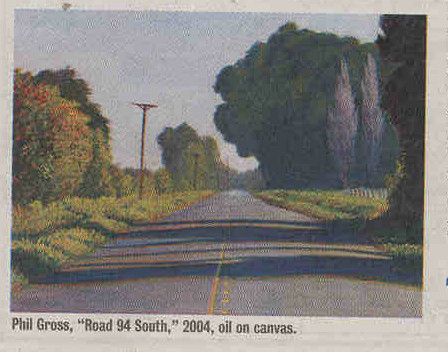 |
Phil Gross, "Road 94
South," 2004, oil on canvas.
|
| |
|
The Valley was appealing to him partly
because it hadn't already attracted
generations of famous painters. It was vast,
it was subtle, and it was lonesome. "It's
hot. It's humid. There are all these lonely
roads in the middle of summer with
105-degree heat. It's all very subtle
terrain, all the greens and grain colors. It
had all this kind of hidden suggestion of
color. It was a cornucopia of color."
Like his peers, Gross was influenced by
Thiebaud and Kondos, but he doesn't believe
that every painting of a river or a field
deserves to be called a "knockoff."
"I would love to do a Thiebaud knockoff,"
said Gross, "but his colors are much more
... extraordinary and wild."
Gross finds that he returns to various
themes over and over again. He likes viewers
to feel as if they could walk right into his
paintings and sense the vastness through an
ever-disappearing horizon line. When he can,
he lets the sun backlight his subjects,
rimming trees and buildings with a warm,
golden light in the late afternoon. It's
called "contre jour," he said, working
"against the day."
Though he works regularly with other
painters, he's not sure if that makes him
part of a movement. "We'll see over time,"
he said, adding, "I like the idea of being
part of it."
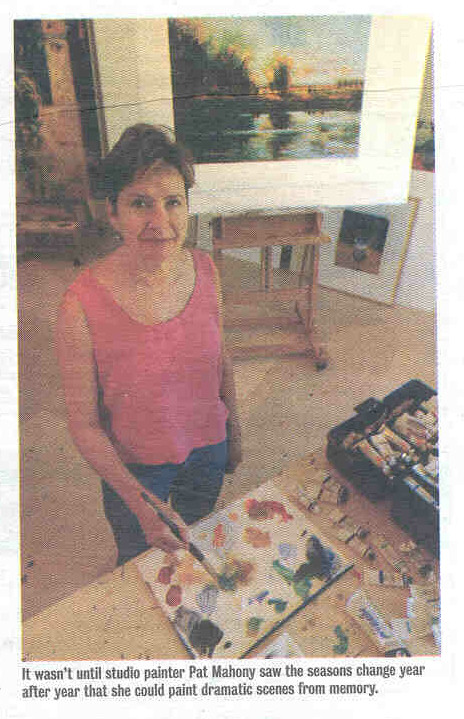 |
Photo By Larry Dalton
|
It wasn’t until studio
painter Pat Mahony saw the
seasons change year after
year that she could paint
dramatic scenes from memory.
|
| |
|
Pat Mahony
Pat Mahony is also influenced by
the work of the painters who came before
her, though she doesn't join others for
"plein-air" painting excursions. Instead,
Mahony paints daily in her airy,
well-equipped studio on the top floor of her
home, preferring to collaborate through
viewing and soliciting critiques from
painters she admires.
"Sacramento has a wealth of talented
painters. I can't imagine a community that
has more talented people and successful
people and serious artists, but it's a small
community. So you see everyone's work. You
see it being reviewed. You see it at the
galleries. You know most of the artists. ...
I would find it impossible not to believe
that there was a Sacramento Valley school of
landscape painters, because we've all been
influenced by one another."
Mahony, a woman in her mid-50s who left
behind years as a stockbroker in favor of a
painting career, finds that when other
artists paint something, she sees it as
material for the first time. She still
remembers looking at Kondos' paintings of
local haystacks in the 1980s. The square
bales of hay, "like a block of ice or a
block of wood," were fascinating, she said,
but she never would have dreamed of painting
them before.
"So, all of the sudden when someone else
has done a crop of trees, an orchard, you
tend to look at an orchard and say, 'You
know what? I see what he saw. I see what
that person had in mind. I see those
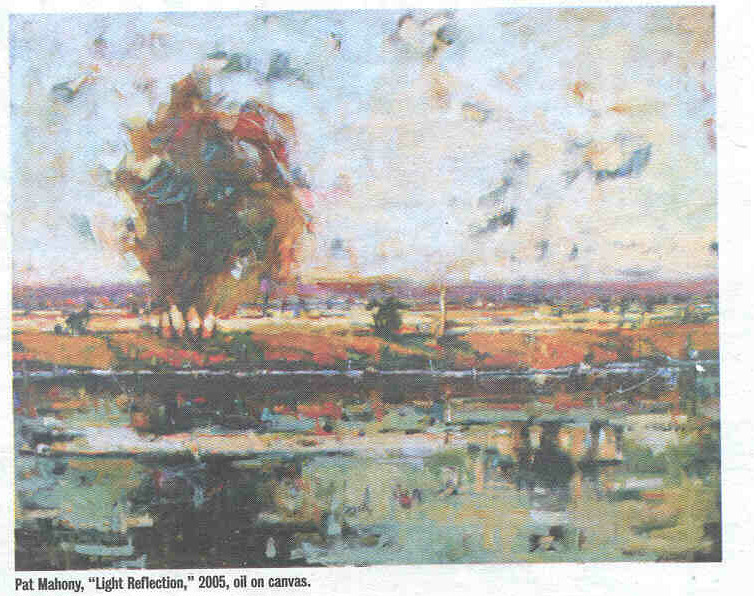 |
Pat Mahony, "Light
Reflection," 2005, oil on
canvas.
|
| |
|
shadows. I see the colors.' It's really
an education in learning to see."
And there's a lot to see.
"Once you go across the causeway, once
you get to the Sacramento River, you get
nothing but landscape," she said. "It used
to be that if you went north of downtown,
there was nothing but landscape to the
airport. You go south to Courtland, you've
got all the pear groves. South, you've got
the tomato fields. If you look east, you
tend to see more foothills and the
mountains."
With all that material, Mahony stays
close to the
landscapes she's most intimate with.
After watching the seasons change the river
over the years, she learned to paint it from
memory, to paint with abandon, like a singer
using her whole heart and soul to sing.
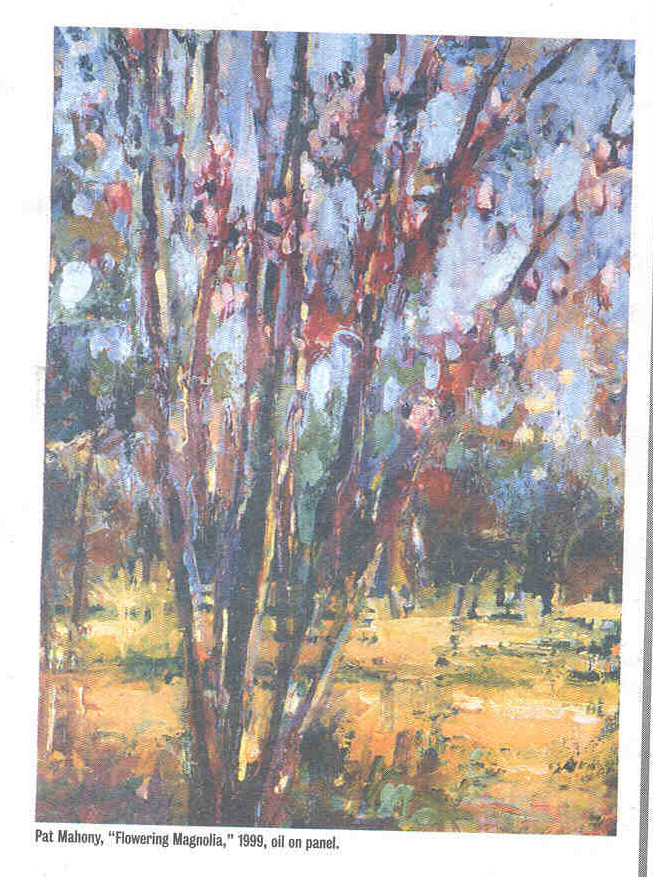 |
Pat Mahony, "Flowering
Magnolia," 1999, oil on
panel.
|
| |
|
"I've traveled extensively, and always in
search of new subject matter, new light, new
circumstances, new inspiration--and I always
come home to what I know."
Roy Tellefson
Roy Tellefson was a student of both
Thiebaud and Kondos, and the two
professors encouraged him to attend the San
Francisco Art Institute, which he did in the
1970s. Slides from that time show a
starry-eyed, longhaired young man sitting in
front of large, frenetic landscape
paintings.
Though Tellefson worked for decades as a
drafter with the Sacramento Area Council of
Governments, he retired in the mid-1990s and
was able to paint exclusively for a couple
of years before he died of cancer in 1996.
Tellefson left behind a number of
landscapes in private collections and along
the walls of his family home, where his
wife, Sue Tellefson, reminisced about the
couple's regular Sunday drives looking for
material to photograph and paint.
"Oh, God," said Sue. "We went everywhere.
We'd go toward Stockton, out to the
countryside. We'd be gone for hours."
The couple's son Kevin recalls that those
drives were a lifelong pleasure. Even as a
child, Roy spent days riding through the
rural landscape. "He was fascinated by the
concept of the big sky. So, they'd be out in
rural areas, and he would see an isolated
building with the big sky behind it."
"I always loved his skies," said Sue. "He
just wouldn't do a blue sky."
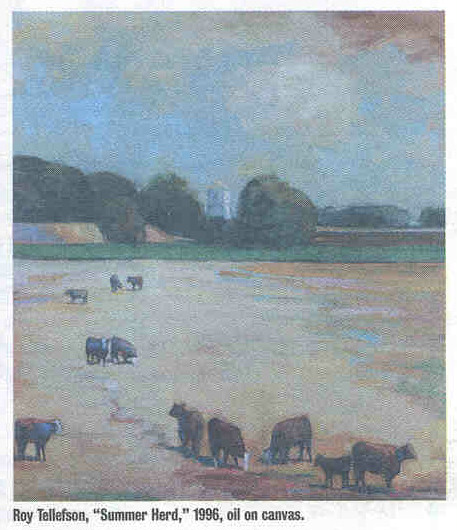 |
Roy Tellefson, "Summer
Herd," 1996, oil on canvas.
|
| |
|
In an essay prepared shortly before his
death in 1996, Roy spoke about his
attachment to the land: "About 15 years ago,
I realized that as a painter my interests
were moving toward the Sacramento Valley
landscape. I began to understand that I was
being drawn toward something in the land
that gave me spiritual fulfillment and
emotional satisfaction." That satisfaction
came from his engagement with "the land and
its symbols." He wrote, "I do believe that
we see the landscape in terms of raw
archetypes of powerful emotions."
Speaking specifically about our valley,
Roy added, "Within the Great Central Valley,
the most significant feature is isolation.
We are overwhelmed by the space in, around,
and above objects. Farm houses become overly
significant because of their isolation
within the total framework. The meandering
shape of a tree grove or river levee can
become a significant symbolic wonderment
when played off of ground and sky. This is
something we all have a collective
experience toward."
Did that collective experience secure the
survival of all that open ground and sky?
"I think he recognized the value of the
unadulterated environment around him," said
Kevin, "because he knew it was going to
change."
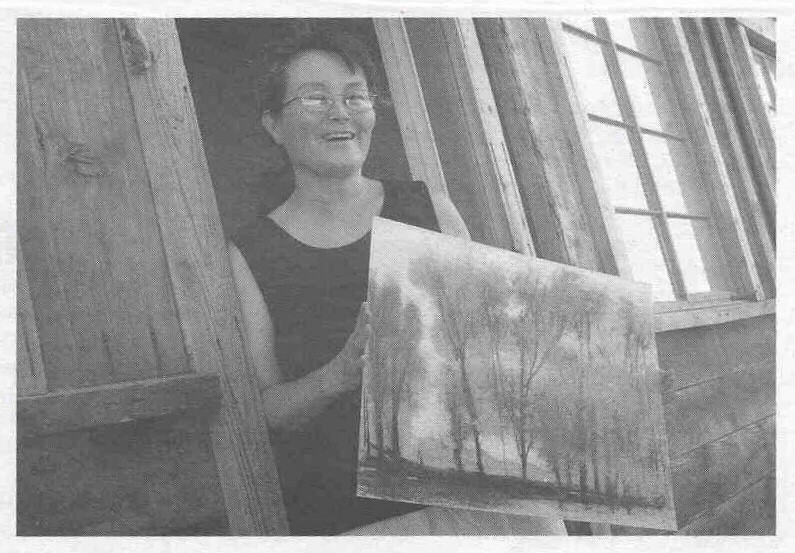 |
Photo By Larry Dalton
|
Pastel artist Diana
Childress likes working with
reflections on the water,
along with the Valley’s rows
of olive trees, which remind
her of bent old people.
|
| |
|
Diana Childress
Diana Childress, a sweet-faced woman
with high cheekbones and a disarming
honesty, is primarily a pastel artist who
spent most of her adulthood as a weaver.
Standing in her studio among a stack of
newly commissioned pastels, she mentioned
that some of her woven clothes show up in
John Travolta movies.
Like Tellefson, Childress' early love of
the Valley came from years of driving
through it as a child.
"As we drove along, you'd see those rows
of fields that would run by the car as
you're going by. I just thought that was
fantastic. And the tall eucalyptus trees,
and the windbreaks when you get up there in
the fields."
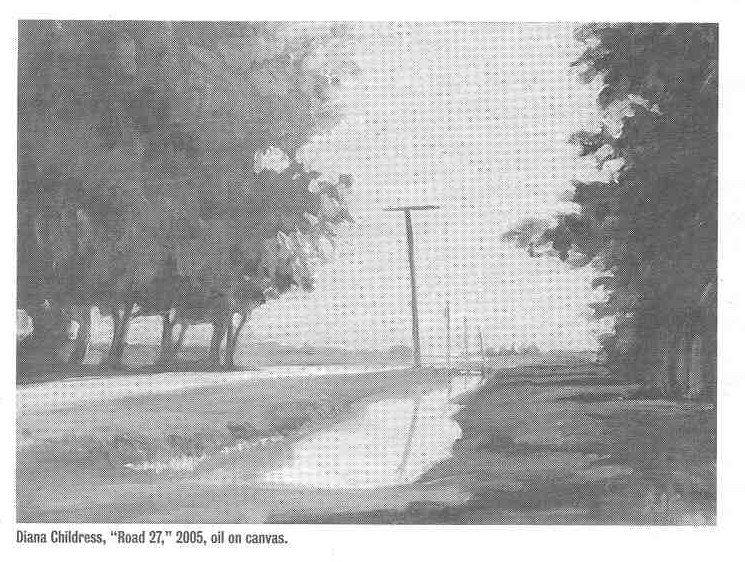 |
Diana Childress, "Road
27," 2005, oil on canvas.
|
| |
|
One of the ways her parents kept her
quiet on drives was to ask her, "Do you know
what's growing out there?"
"Little by little, through that, I
learned about what tomatoes look like in the
field, or potatoes, or onions, or orange
groves," she said.
Childress, also in her early 50s, came to
the Sacramento Valley to raise her son. "At
first, it was kind of hard living here. I'd
always lived in these really beautiful areas
of California along the coast. But just in
living here year-round, I discovered that
it's really beautiful."
She now has favorite places. "One of them
is Willow Slough, which is just north of the
causeway. ... If you
 |
Diana Childress, "Olives
at the Turn No. 6," 2005,
pastel on paper.
|
| |
|
look north, of course, you see the
railroad trestle and the bridge there.
Beyond that, and between the county landfill
and the dump and all that, is this huge,
wonderful stretch of swampy land that's all
natural, and that's Willow Slough. ... It's
irresistible."
Childress, with her one-room studio in
Winters and her seven-day workweek, hasn't
participated in a lot of dialogue about the
"school" with painters like Mahony and
Chandon.
"I think that maybe this particular area,
this part of the county, hasn't really been
portrayed in painting, so people who love
this area are jumping at the chance to have
something that connects them to that. ...
More than a 'school' really, it's the
community responding to me and all these
other artists. We're all educated enough now
that we know our farmland is on the verge of
disappearing, maybe is at risk. This is a
way for all of us to hold on to some of
that."